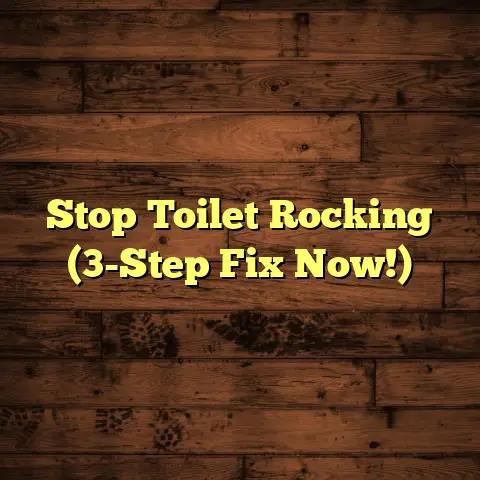Dog Afraid Of Wood Floors? (4 Causes To Check!)
Imagine this: You’ve just installed beautiful new hardwood floors. You’re picturing cozy nights, a clean, modern look, and maybe even a boost in your home’s value.
But then you see it. Your dog, your best buddy, the one who usually zooms around like a furry tornado, is now frozen at the edge of the room. Tail tucked, ears drooping, eyes wide with… fear?
It’s heartbreaking, isn’t it? What should be a happy improvement to your home is now a source of anxiety for your beloved pet. As a flooring contractor, I’ve seen this scenario play out more times than I can count.
It’s tough on both the dog and the owner. You want your dog to feel safe and comfortable, and you want to enjoy your new floors without feeling guilty. So, what’s going on?
Why is your dog suddenly afraid of wood floors? Let’s dive into the four most common causes. I’ll share my insights, based on years of experience and countless conversations with worried pet parents.
I. Understanding Canine Psychology:
It’s Not Just About the Floor
Before we get into the specifics, let’s take a quick look at how dogs think and feel. It’s easy to forget that their world is very different from ours.
Dogs rely heavily on their senses, especially smell and hearing. They also have a strong sense of territory and routine. Change can be unsettling, and new environments can be downright scary.
-
Innate Instincts: Think about a dog’s wild ancestors. They needed to be cautious and aware of their surroundings to survive. That instinct is still present in our domesticated dogs.
-
Early Experiences: The first few months of a dog’s life are crucial. Positive socialization during this period helps them become confident and well-adjusted. If they haven’t been exposed to different surfaces, sounds, and environments, they may be more prone to fear later on.
-
Fear Manifestation: Fear in dogs can show up in many ways. Some dogs might whine, bark, or tremble. Others might become withdrawn, hiding under furniture or refusing to move. Some might even have accidents indoors. The key is to recognize the signs and understand that your dog isn’t being stubborn or disobedient. They’re genuinely scared.
So, with that in mind, let’s explore the specific reasons why those beautiful wood floors might be causing your dog distress.
II. Cause 1: Traumatic Experiences –
A Slip Can Leave a Lasting Scar
Imagine you’re walking on ice and you slip and fall. It’s a jarring experience, right? Now imagine that happening to your dog, but they don’t understand why. They just know that this new surface is dangerous.
-
The Slip and Slide: One of the most common reasons for a dog’s fear of wood floors is a previous slip or fall. Wood floors can be slippery, especially for dogs with long nails or those who are used to the traction of carpet.
-
Anecdotal Evidence: I once worked with a client whose golden retriever, Buddy, was terrified of their newly installed hardwood. After some digging, we discovered that Buddy had slipped and fallen while chasing a toy on the floor shortly after installation. The incident, though minor, had created a strong negative association.
-
Recognizing the Trauma: It’s important to remember that dogs don’t generalize well. They might not understand that all wood floors aren’t dangerous, just the one where they had a bad experience. This can lead to a generalized fear of any smooth, hard surface.
Do you think your dog may have had a bad fall? If so, you’ll want to slowly and gently reintroduce your dog to the flooring.
III. Cause 2: Sensory Sensitivities –
It’s Louder and Slicker Than You Think
Think about how different wood floors feel and sound compared to carpet or grass. For us, it’s a minor difference. But for a dog with heightened senses, it can be a sensory overload.
-
The Sound of Silence (and Echoes): Wood floors reflect sound differently than carpet. This can create echoes and amplify noises, which can be unnerving for dogs with sensitive hearing. The “click-clack” of their nails on the floor can also be a source of anxiety.
-
The Texture Tango: The smooth, hard texture of wood floors can feel slippery and unstable to dogs, especially those with longer fur between their toes. This lack of traction can make them feel insecure and vulnerable.
-
Breed Sensitivities: Some breeds are more prone to sensory sensitivities than others. Herding breeds, like Border Collies and Australian Shepherds, are often highly sensitive to sound. Toy breeds, like Chihuahuas and Yorkshire Terriers, can be easily intimidated by large, open spaces and unfamiliar surfaces.
Breed Common Sensitivities Border Collie Sound, Movement Chihuahua Size of Space, New Surfaces Australian Shepherd Sound, Visual Stimuli Greyhound Slippery Surfaces German Shepherd Sound, Instability Data compiled from anecdotal evidence and breed-specific behavioral studies.
Are you noticing these sound sensitivities with your dog? What breed is your dog? This could be contributing to their fear.
IV. Cause 3: Lack of Familiarity –
New Can Be Scary, Especially for Anxious Dogs
Imagine moving to a new city where you don’t know anyone or anything. It can be overwhelming, right? That’s kind of how your dog feels when you suddenly replace their familiar carpet with a shiny new wood floor.
-
The Carpet Comfort Zone: Dogs often develop a strong sense of comfort and security with familiar surfaces, especially carpet. Carpet provides warmth, traction, and a sense of stability. It’s also familiar – they’ve likely spent a lot of time lying on it, playing on it, and sleeping on it.
-
The Transition Trauma: Suddenly replacing that familiar carpet with a hard, cold wood floor can be a shock to the system. It’s a completely different sensory experience, and it can take time for a dog to adjust.
-
Gradual Exposure is Key: The key to helping your dog overcome this fear is gradual exposure and positive reinforcement. Start by placing rugs or runners in strategic areas to provide familiar footing. Then, slowly introduce your dog to the uncovered areas, using treats and praise to reward brave behavior.
This is a process that takes time and patience. Don’t rush it, and don’t force your dog to do anything they’re not comfortable with.
When I’m helping clients with this, I always recommend starting small. Maybe just a few minutes of exposure each day, gradually increasing the time as your dog becomes more comfortable.
However, this method may pose challenges for anxious dogs. Some dogs are just naturally more anxious than others. If your dog has a history of anxiety or fear, they may need extra support and patience to overcome their fear of wood floors. In these cases, consulting with a professional dog trainer or behaviorist is always a good idea.
V. Cause 4: Health Issues –
Sometimes, It’s Not Just Behavioral
Sometimes, a dog’s fear of wood floors isn’t just about the floor itself. It can be a sign of an underlying health problem.
-
Joint Pain and Arthritis: As dogs age, they can develop joint pain and arthritis. Walking on hard surfaces like wood floors can exacerbate this pain, making them reluctant to move around.
-
Vision Problems: Dogs with vision problems may have difficulty judging distances and navigating unfamiliar environments. This can make them feel unsteady and insecure on smooth, hard surfaces.
-
Neurological Issues: In rare cases, a dog’s fear of wood floors can be a sign of a neurological problem. These conditions can affect their balance, coordination, and spatial awareness, making it difficult for them to walk on any surface.
Health Issue Potential Symptoms Arthritis Stiffness, limping, reluctance to move Vision Problems Bumping into objects, hesitant movement Neurological Issues Loss of balance, disorientation, head tilting Consult with a veterinarian for accurate diagnosis.
If you suspect that your dog’s fear of wood floors might be related to a health problem, it’s important to consult with your veterinarian. They can perform a thorough examination and run tests to rule out any underlying medical conditions.
Conclusion:
Empathy and Understanding Are Key
So, there you have it. The four most common causes of a dog’s fear of wood floors:
-
Traumatic Experiences: A slip or fall can create a lasting negative association.
-
Sensory Sensitivities: The sounds and textures of wood floors can be overwhelming for some dogs.
-
Lack of Familiarity: New environments can be scary, especially for anxious dogs.
-
Health Issues: Joint pain, vision problems, or neurological conditions can make it difficult for dogs to walk on hard surfaces.
Remember, your dog isn’t being difficult or stubborn. They’re experiencing a genuine fear, and they need your help to overcome it. By understanding the reasons behind their fear and taking steps to address it, you can help your furry friend feel safe and comfortable in their home once again.
As a flooring contractor, I’m passionate about creating beautiful and functional spaces. But I’m also a pet owner, and I understand the importance of creating a home that’s comfortable and safe for all members of the family.
So, take the time to understand your dog’s perspective. Be patient, be understanding, and be willing to make adjustments to your home to accommodate their needs. In the end, it’s all worth it to see your best buddy happy and relaxed in their own space.





